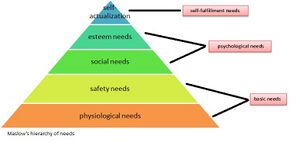Need
Need is defined as the state of absence of something (things, phenomena, processes) and at the same time as the factor which initiates a motivation to change this state. A person can be aware of your needs or not, because some needs are hidden. needs may be possible to achieve. Sometimes, in the event that the funds are not enough, the needs might be postponed. Satisfaction of needs bring happiness and is a source of the individual development[1][2]
Examples of Needs
- Physical Needs: These are basic physiological needs such as food, water, shelter, and sleep.
- Emotional Needs: Humans need to feel a sense of belonging, love, and acceptance.
- Social Needs: We need friends and family to interact with and to be part of a community.
- Intellectual Needs: We need stimulation and challenges to help us grow and develop.
- Spiritual Needs: Humans have a need to find meaning and purpose in life.
- Financial Needs: We need money to buy the basic necessities of life.
Maslow's hierarchy of needs
Abraham Maslow, known psychologist, created a model (pyramid) of human motivation called also hierarchy of needs. needs are arranged hierarchically from the basic to the more advanced. Firstly, basic needs must be met before the needs from higher order[3][4]
Maslow's hierarchy of needs includes:
- physiological / biological needs - generally all basic life needs without human cannot function like: air, food, sleep, water, homeostasis. To start thinking about the needs from 2nd level we cannot worried about basic needs.
- safety needs - security, protection, family, health, comfort, peace. People need have things under control and they need to know that everything is fine - it is natural desire.
- social needs - family, friendship, love, belonging. Without love or being loved, people can be depressed and different anxieties can arise. It is important to not miss any elements.
- esteem needs - confidence, achievement, respect of others and by others, status, reputation, prestige. People want to be good at something to be admired by others. Glory brings happiness and satisfaction.
- self-actualization - personal growth, creativity, morality. Realization of the individual potential. Focus in something which is important for someone.
Economic growth, education and higher revenues cause that attention is paid to the needs of higher-level such as: success at work, school, appreciation and understanding by others, etc.
Other needs
In Dictionary of Psychology written by A. Rober [5] there are listed some other needs like:
- affiliation - spending time with people
- emotional closeness - intimate relations
- exhibitionism - providing others with entertainment
- creating - construction the systems
- submissiveness - admiring leaders
Advantages of Need
Needs are an essential part of our lives and bring a variety of advantages.
- Firstly, they motivate us to strive for betterment and improvement of our lives.
- Secondly, they help us to prioritize our goals and objectives.
- Thirdly, they can help us to identify our strengths, weaknesses, and areas of improvement.
- Fourthly, they can provide us with a sense of purpose and direction.
- Lastly, meeting our needs can lead to inner peace and satisfaction.
Limitations of Need
Needs are limited in many ways. These limitations include:
- Time constraints: Time can be a limiting factor in satisfying needs. In many cases, needs must be fulfilled within a certain timeframe, which can be difficult to achieve.
- Resources: Resources such as money, materials, and people are limited and this can limit what needs can be satisfied.
- Emotional and physical states: Emotions and physical states such as fatigue and stress can limit a person's ability to satisfy their needs.
- Cultural norms: Cultural norms and values can restrict the ways in which needs are expressed and fulfilled.
- Social environment: The social environment, both at home and in the workplace, can limit the satisfaction of needs. This can include social pressures, expectations, and judgments.
- External factors: External factors such as laws, policies, politics, and the economy can all have an effect on the satisfaction of needs.
Needs can be approached from different perspectives. For example:
- Psychoanalytic Approach: The psychoanalytic approach looks at needs as unconscious desires that are often in conflict with conscious desires. It suggests that when these unconscious needs are not met, individuals may develop psychological issues.
- Humanistic Approach: This approach emphasizes the importance of self-actualization, or the need to reach one's fullest potential. It suggests that all humans have an innate need to grow and develop.
- Cognitive Approach: This approach suggests that needs are determined by the individual's thought processes and beliefs. It suggests that beliefs and expectations influence the way in which needs are met.
In conclusion, needs can be approached from multiple perspectives, including psychoanalytic, humanistic, and cognitive. Each approach has its own strengths and weaknesses, and it is important to consider the individual's needs and beliefs when determining the best approach.
Footnotes
- ↑ W. Šmid, Marketing pod presją globalizacji: nowe wartości, hierarchia potrzeb, zarządzanie, metamarketing, Agencja Wydawnicza Placet, 2002.
- ↑ Philip G. Zimbardzo, Psychologia i życie, Wydawnictwo Naukowe PWN, 1994
- ↑ W. Šmid, Marketing pod presją globalizacji: nowe wartości, hierarchia potrzeb, zarządzanie, metamarketing, Agencja Wydawnicza Placet, 2002.
- ↑ K. Obuchowski, Przez galaktykę potrzeb: psychologia dążeń ludzkich, Zysk i S-ka Wydawnictwo, cop. 1995.
- ↑ W. Šmid, Marketing pod presją globalizacji: nowe wartości, hierarchia potrzeb, zarządzanie, metamarketing, Agencja Wydawnicza Placet, 2002.
| Need — recommended articles |
| Primary needs — Psychological drives — Motivation — Social bond — Dimensions of stress — Psychological age — Natural environment — Motivation theory — Attitudes and behaviour |
References
- Citrin, A. V., Stem, D. E., Spangenberg, E. R., & Clark, M. J. (2003). Consumer need for tactile input: An internet retailing challenge. Journal of Business research, 56(11), 915-922.
Author: Gabriela Brzęk
